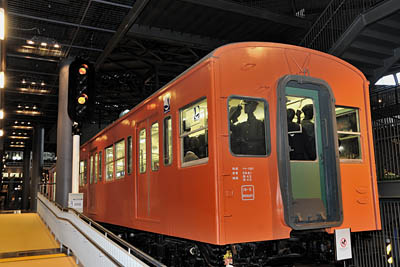
Electric Railcar
Class
|
The electric multiple unit series provided the foundation for modern commuter electric trains. (Ku = Driving car, Mo = Motor car, Ha = 2nd passenger class) |

|
|
After WW2, the Tokyo area urban lines, needed improvement because of the increase of commuters.
As a result, during 1956, JNR planned development based on the totally new design philosophy for a new model
that could largely increase it's transporting capacity.
During June 1957, ten Class MoHa-90 test cars were manufactured based on this planning. This experimental car saw great improvement in motor performance, noise reduction etc ... Also, interior comfort was improved. For example, expanded doors and windows, improved lighting conditions.... etc. Formally, the body painting had only one brown color, then it was changed to more brighter hues. (At first the MoHa-90 was Orange colored, and it's color was later determined by what line it belonged to.) Therefore, MoHa-90's differed in appearance from conventional commuter type cars. After many test runs, improvements were made of the prototype, and forty-six first production units were ordered during 1957. The first unit was completed on the 10th of March 1958, and it was deployed to Mitaka depot for it's debut on the Chuo line. These units were named the Series-101 Electric Railcar. Prototypes of Class MoHa-90 were renamed in the Nine-Hundreds of Series-101. Series-101 deployment was started from the Chuo line and gradually replaced the old model on the Yamanote, Sobu lines and Osaka urban area lines. Finally, Series-101 saw a manufactured total of 1,535 up to 1969. Almost all of Tokyo and Osaka area's short-range commuter trains were replaced by the Series-101, and they became the most popular urban commuter electric car. However, their culling began during 1979, and the succession Series-103 or 201 appeared. Chuo line's Series-101 were all replaced by their heir models by March of 1985. Yet, 224 cars were still active on local lines, even in 1987, when JR private companies began. In the Osaka area, fourteen Series-101 survived on the Katamachi line, but they were retired during March of 1991. (The Good-Bye train ran on the 29th of Apr 1991) In the Tokyo area, Series-101 were almost all retired by the year of 1992, some survived only on one section of the Hama-Kawasaki - Shitte on the Nanbu branch line. The last Series-101's were Class KuMoHa-101 No.130 and Class KuMoHa-100 No.172 and were retired during November 2003.
|
|
Preserved car No.KuMoHa101-902 (1957 - 1985)
In the Museum, the exhibition of Class KuMoHa-101 No.902 was one of the ten cars which were experimentally manufactured as the first Series-101 unit. It was manufactured in the JNR Oi workshops during 1957, and was named the MoHa-90 No.503. On the 1st of June 1959, MoHa-90503 was remodeled and was renamed to Class KuMoHa-101 No.902. KuMoHa101-902 was first deployed to the Mitaka depot and it worked on the Chuo line for a long period. But it was transferred to the Nakahara depot on the 9th of March 1978, and was active on the Nanbu line. Finally, it was retired during March 1985. After retirement, it was preserved in it's hometown Oi workshops (currently JR-East Tokyo General Rolling Stock Center) in recognition of her achievements. When the Saitama Railway Museum was opened during October 2007, KuMoHa101-902 was moved to the new Museum.
|
Introduction |
Go to Top |